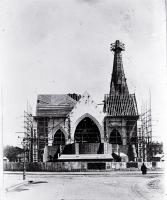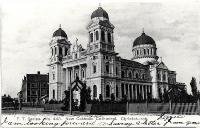ChristChurch Cathedral
Although Christchurch had become a city in 1856 when the Reverend Henry John Chitty Harper was appointed Anglican Bishop, he still did not have a cathedral to hold services in ten years later.

The cornerstone had been laid on 16 December 1864, and the foundations had been completed in 1865. But the money had run out, with some people arguing that the Church had more important things to spend its money on. At one point the site was almost sold off.
Bishop Harper managed to get building started again by promising some of his own salary to help costs. Other leading people in the community supported him and building began again in 1873, with Benjamin Mountfort, architect of the Provincial Council buildings and other Gothic-style buildings in Christchurch, as supervising architect (looking after the day-to-day work on the building site).
The original plans for the cathedral had been drawn up by Sir Gilbert Scott. He had wanted to build the cathedral in timber, but changed the plans when a good supply of building stone was found in Canterbury.
Mountfort wanted to make some changes of his own, but the Rhodes family, who had put a lot of money towards the project including eight bells and a memorial window, objected, and the original plan was kept. Mountfort was able to make some later changes to the tower and spire, and added some decorative features to the outside.
By 1881 the nave and the tower had been completed and consecrated. The addition of thechancel and the transepts completed the building in 1904. A west porch designed by Mountfort had been added in 1894.
The cathedral was built mainly of Canterbury stone. The timber in the roof came from matai (black pine) and totara trees on Banks Peninsula, where it was pit-sawn before being carted to Christchurch.
The nave is about 100 feet long, and the circular stone staircase to the tower has 133 steps. In the West Porch is the bench-mark for Christchurch - 6.192 metres (20.314 feet) above mean sea level .
Read more on the page about ChristChurch Cathedral.
Sources
- Lee, Marian. ChristChurch Cathedral, Christchurch, New Zealand, Christchurch, [199-].
- Rice, Geoffrey W. Christchurch changing: an illustrated history. Christchurch, 2000.
- Federation of University Women, Canterbury Branch. Round the square: a history of Christchurch's Cathedral Square, Christchurch, 1995.
The Cathedral of the Blessed Sacrament
In 1857 a plot of land in Barbadoes Street was granted to the Roman Catholic church for a place of worship. Three years later a small wooden chapel was built on the site for the cost of £75 and services began there.
The first Roman Catholic Bishop of Christchurch was the Most Reverend John Joseph Grimes, appointed on 7 May 1887. He arrived in Christchurch on 2 February 1888, and took office that evening in the Church ofthe Blessed Sacrament in Barbadoes Street.
This wooden building had been designed by Benjamin Mountfort, the Provincial architect, and had opened in 1864. During the 1870s it had been added to as the number of Catholic worshippers grew. This building was later moved to one side of the site by traction engines to make room for a new cathedral.
Bishop Grimes had won support and some funding for a new Cathedral, and in 1899 met with the Dunedin architect, Frank Petre, to discuss the project.

The laying of the foundation stone took place in a ceremony on 10 February 1901. At one point there were problems with finding enough good quality stone, and then the money ran out. The New Zealand Premier, Richard Seddon, heard of the difficulties over money and pushed a special bill through Parliament so that the Bishop could take out a loan on behalf of the Roman Catholic Diocese to finish the cathedral.
By the time the cathedral was officially opened on 12 February 1905 the project had cost £52,213.
The new cathedral was built of approximately 100,000 feet of Oamaru stone and 20,000 feet of Mount Somers stone, with very little wood. It measured 210 feet by 106 feet, with the dome 135 feet high. Unlike the strong Gothic influences of the Anglican cathedral and other buildings in the city centre, it was based on the Renaissance style of architecture, and is regarded as the best example of this style in New Zealand.
There is a story that when the well-known playwright George Bernard Shaw visited Christchurch in 1934, he complimented the city on its beautiful cathedral. His hosts thought he meant the one in Cathedral Square. ‘No’
, he replied, ‘the one down by the gasworks.’
Read more on the page about The Cathedral of the Blessed Sacrament.
Sources
- The Jubilee year: Cathedral of the Blessed Sacrament, Christchurch, New Zealand 1905-1980, Christchurch: The Cathedral, 1980.
- Rice, Geoffrey W. Christchurch changing: an illustrated history, Christchurch, 2000.

